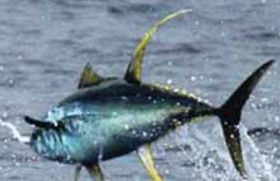 Presented from Issue 108, February 2014
Presented from Issue 108, February 2014
The weather in Tasmania is sometimes unpredictable and the start to the “warm” weather was a bit iffy.
The weather gods have it well sorted now and water temps and ambient air temps are on the rise. If you have seen the Disney Movie NEMO you will know The East Australia Current is great for turtles, but it is also wicked for tuna fishermen.
The East Australia Current or EAC has been balled up off Eden and is ever so slowly making its way down the east coast of Tasmania. By the time you read this the albacore will have thickened right up off the east coasts of Tasmania after a slow start.
Warm currents from the east meeting the cooler currents from the south east will for temperature breaks. In around those temp breaks will hopefully be some good numbers of yellowfin tuna. We have had a number of lean years when it comes to yellowfin and it is time to think smarter, try harder and try new things.
The yellows are often on the edge of the current and temp lines. Habitating in the warmer water and breaking out into the cooler water to feed. These temp breaks and current lines hold the nutrients that attract the krill that inturn have the small pelagic bait fish feeding on them. It is what is next in line that is of interest to us.
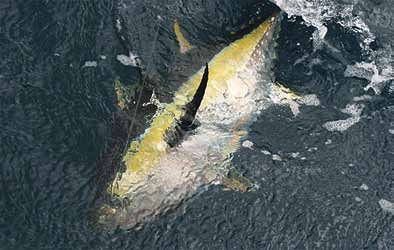 The yellows
The yellows
The yellowfin tuna is among the larger tuna species, reaching weights of over 400 pounds (180 kg). Tasmania is not famed for its large yellowfin and the mens 24kg record sits at 87kg. The east coast has been known to turn over good fish between 40 – 60 kg. Yellowfin tuna love to eat other fish, pelagic crustaceans, and squid. Like all tunas their body shape is designed for speed, enabling them to pursue and capture fast-moving baitfish such as red bait, sauries, and mackerel.
Yellowfin will often travel in schools on their own, however will often travel with other fish species. It is not uncommon to find them with schools of striped tuna.
The next time you are off the coast and had have enough of a school of stripeys, try something different. Upsize the lures considerably if using pushers or try getting under them by using deep divers. Slow down and really try and let the bib work its magic and get in under the school of stripeys. Letting a lot more line out than you might normally thing “right” will help the lure gain maximum depth. Yes you may be pestered still by the little skipjacks, but you also might find yourself hooked up to a nice yellowfin. You will not have had that happen if you had just motored off leaving the striped tuna in disgust.
They will also travel with dolphins and whales and spend some time around any floating flotsam that you may come across. So keep a keen eye out and always motor over and check something that has some size about it while trolling.
Many seasoned anglers hold yellowfin in high regard. Pound for pound they are said to be the fastest and strongest of all big game tuna. It is sometimes said that a yellowfin tuna will pull a Bluefin tuna of the same size backwards.
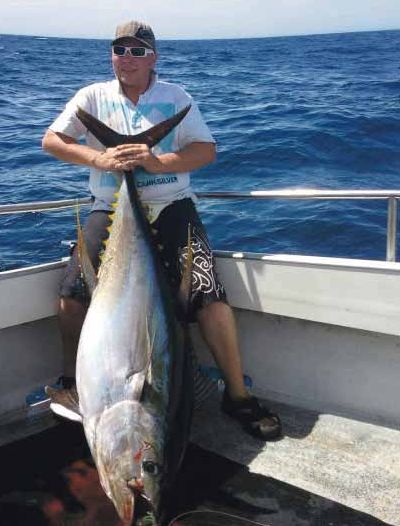 Gear
Gear
Like I have said in the past a good size egg beater reel of reasonable quality will hold you in good stead with fish to 50kg. Over that and a traditional over head will be the reel of choice. Very hard to go past the new PENN Squall 2 speeds at the moment. They come in 3 sizes and the package available at the minute including rod, reel and gimbal belt is hard to fault.
If you are not fishing in competition where line class is a concern fish as heavy as you can. 24 and 15 kg is perfect and will keep you in with a chance should you stumble upon that upsized specimen or a hungry marlin. Get yourself a knot book and practice tying a double — plait or bimini style it doesn’t matter. What ever you are more comfortable tying and can remember to tie stick with it. The staff in a good tackle store will be more than happy to get the job done until you have it under your belt.
Where to start
Although mainly found in deep offshore waters, yellowfin tuna will approach shore when the right conditions exist. The reason they venture in is food. Squid and mackerel will be the food of choice off Tasmania and any structure can harbor yellowfin feeding on the baitfish these spots hold inclose to the shoreline. Yellowfin may venture well inshore of the continental shelf when water temperature and clarity are suitable and food is abundant. A range of good quality lures are a must. A mix of Halco style bibles divers and traditional skirts is a good start. Zukers are a great lure for Yellows but upsizing to the bigger size will help with Striped Tuna bycatch. Leader material is crucial. If ever there is a fish that will try to touch you up at the boat it’s a feisty yellowfin tuna. To that end a top quality fluoro carbon like Momoi’s NEO is a good start. It is a 100% hard fluoro that will resist abrasion. Its of a quality that allows smaller line diameter for poundage breaking strain and this is crucial when trying to fool the wily yellow.
So get out there and go find some. Keep your eyes peeled for any surface disturbance that may indicate some distressed bait. Slowly work the edges and keep an eye on the sounder for anything of interest. Don’t forget to look skyward and monitor bird activity. If you have a crew of four put them on duty across the sectors of the boat and concentrate. If you have a few cobbers out in other boats decide where you are going the night before and work different areas. If one boat comes across some action get on the radio and let them know. There will be fish out there but there is a massive amount of water between then and every little bit helps.
... and bluefin too
Tasmania had a crazy southern bluefin run last year. Just plain crazy. School fish were big in the early part of the season but quite sporadic. Then Victorian NAVICO representative Bill Milonas came over from the big island and plucked a 127 kg specimen right from under ‘the rock’ early. This set the Island on fire and the game fishing community was all awash with ‘what ifs’
Come to Tasmania they said…Have a fish they said.
The Hippolyte rocks are well known for holding bait that draws tuna in and holds them for months. Big and little Hippolyte are home to school size southern bluefin tuna that roam between Tasman Island, the continental shelf and back to the rocks. The small township of Eaglehawk Neck swells to the numbers of recreational fisherman who take advantage of the unique topography and short run to the fishing grounds. The ramp at Pirates Bay is a short 7nm run to some of the world’s best southern bluefin fishing.
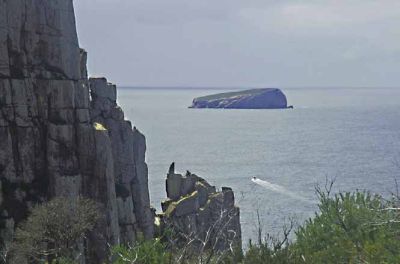 Big Hippo
Big Hippo
Big three figure Bluefin are the target around the colder months as the redbait school up in and around the many underwater haunts stretching from the picturesque Tasman island to the big and little Hippolyte Rock. Traditionally they are thin and far between and take a bit of finding from the wise and canny fisherman who have spent years compiling some local knowledge.
Not last year
The week before the Tom Jenkins Memorial Bluefin tournament big schools of jumbos came to town and tore the place up. There is a mindset that the bigger ‘Jumbo’ fish travel and will only be found in smaller groups.
Rubbish. They came and they came in big numbers and those that found themselves in their way had better have come prepared. There were many fish in the 80 kg to 100kg range. It was not unusual in that month or so to see large areas of southern ocean alive with big powerful bluefin feeding hard and getting their backs out. In a hard blow with a bit of chop and sea spray they would take a lure and turn for the bottom. Looking to join the school again they took some stopping. Long battles over the hour yielded some very good fish.
Happy anglers
These fish took up residence in and around the Tasman peninsular for a number of weeks. The excitement and word soon spread and locals and mainlanders alike made the journey to Pirates Bay for a chance to hook and land that fish of a life time. The weather was not always conducive to helping anglers out. In the calmer days the big tunny would still come up get their backs out and feed hard, but were very selective on what they would inhale. In this sort of mood they were tough to hook. Feeding on the smaller redbait they often snubbed the customary sized skirted and bibbed lures. This proved to be very frustrating to all that witnessed the spectacular scenes.
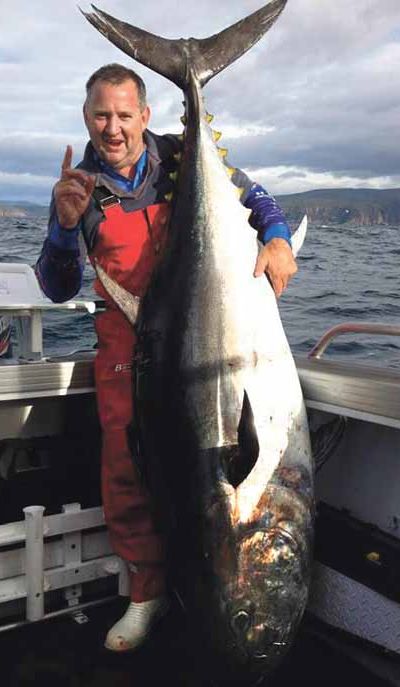
Meat torpedo
The weigh station was peppered with anglers that ticked the big bucket list item and managed to weigh that fish of a lifetime. Pictures of bluefin pulling the scales down near or past that magical 100kg mark with anglers with big smiles were quite common.
Equally as common were the stories of hardship and lost fish. I personally had my arse handed to me by a fish in a stiffening south-westerly. That fish came up and flossed his gills with a Sebile Bonga Jerk we had not long pulled out of the box to give it a swim. Hooked up and heading north along side the little Hippo, he was in a rush to head back to the pack. He screamed line off the 24kg outfit at an incredible rate, had me bent over like a 90 year old man.
No time for facebook now Adrian
This did not end nicely — and in the shallow water I was busted off with such force the rod come out of the gimbal and back into my leg with huge force. The next morning it looked like I had taken a Brett Lee full toss flush on the inner thigh.
The weather and conditions were kind and thank fully we set things right by landing a big fish three hours later. The big Bonga Jerk did the job again and in deep water, and wide, Adrian Morrisby managed to get the fish boat side in just under an hour. Ten seconds later and Clinton Howe and I had 121kgs of southern bluefin on the deck at our feet. The 3 day Tom Jenkins memorial bluefin tournament was the very next day and there were some very excited anglers arriving to hear of Adrian’s fish.
Frustrating
Very tough was the only way to describe the Tom Jenkins event. The tuna were there and they would show and feed a number of times a day but getting them to take a lure was driving most nuts. Graham Purton from Wynyard was one of the lucky ones that managed to hook, battle and land good fish, but alas the seals would ruin his chance to take the glory. Graham’s fish was good enough to take the prize, but seal damage ruled it ineligible and the trophy for biggest fish of the competition went to Stephen Fitzallen on Shanta Marc Largerewskij captain of the Risky Rider crew battled a fish for 4 hours only to have the hook pull and get the old school Zuker grass skirt back fully intact. Marc is a seasoned angler with plenty of experience and on the helm was long time tuna wrangler Johnny Jaws. The drag on the reel checked out later that day and this battle further suggests that there were some serious fish that may have gone well over the 120kg mark.
The madness continued for nearly a month and crews mixed great frustration with immense joy as the fish appeared and fed at will. The word managed to travel across Bass Strait and we saw an influx of mainland crews that were amazed at how close our fishery is to the boat ramps and the cover the coastline can provide in most weather situations. The well set up and experienced mainland crews did a few things a little differently to what we might commonly do here in Tas.
Slightly different
Fishing lighter leader material seemed to provide much better hook up rates for those fish that were stubborn to hit lures. The lures themselves were also a touch smaller than the traditional size we might always go to. This is a combination that is not new to other styles of fishing of course, but is something worth trying when the tunny are being very selective. I noticed a couple of the crews doing well were also trolling that little bit quicker than the 6 to 7 knots that is the norm. I didn’t get a chance to speak to them to ascertain speed, but it makes sense if something you have done ‘all the time’ is not working, try some variables. As always with fishing just when you think there may be a system and a train of thought to matching the hatch and downsizing the lures to match the redbait being fed upon, something throws a curve ball.
The third and final day of the Tom Jenkins was called off because of heavy 50 + knot winds from the North West. This had some of the bigger boats still being able to fish in and around Tasman Island. One such vessel was South East Charters skippered by Michael. They managed to pick up 2 nice tuna that went 101kg and 128kg One of which had 2 mutton birds and a little storm petrel in its stomach. I happened to see these and they looked like they were eaten 5 minutes before capture. Crazy !
That was the season 2013 season in a nutshell really, crazy, but in a good way. Let’s hope season 2014 is even crazier.
Kelly Hunt
